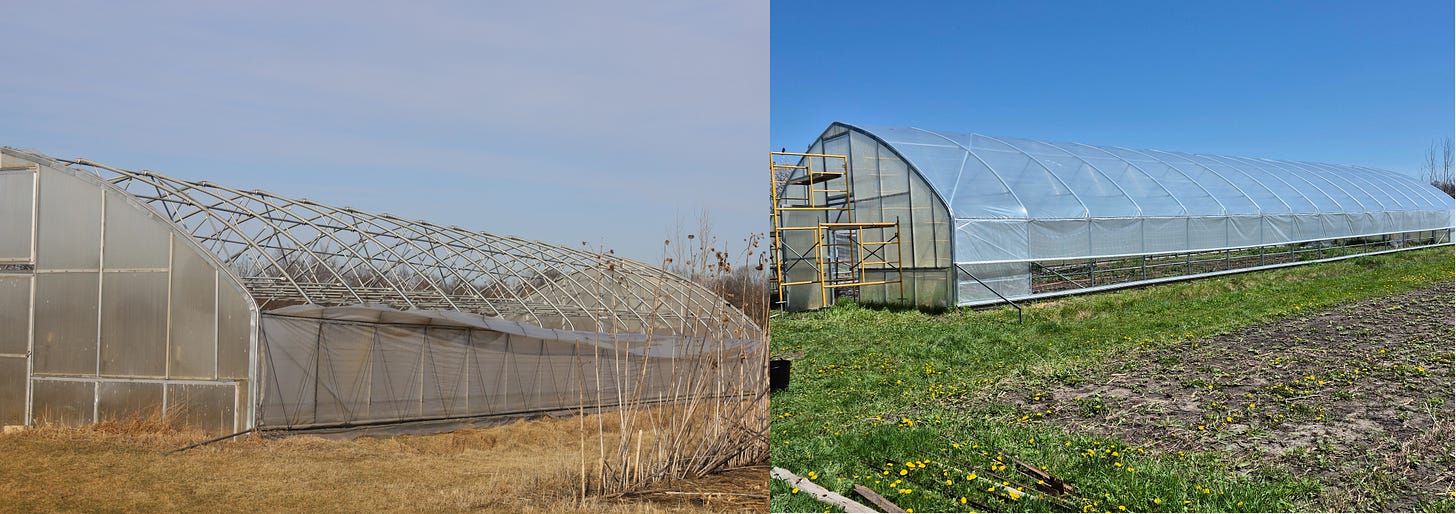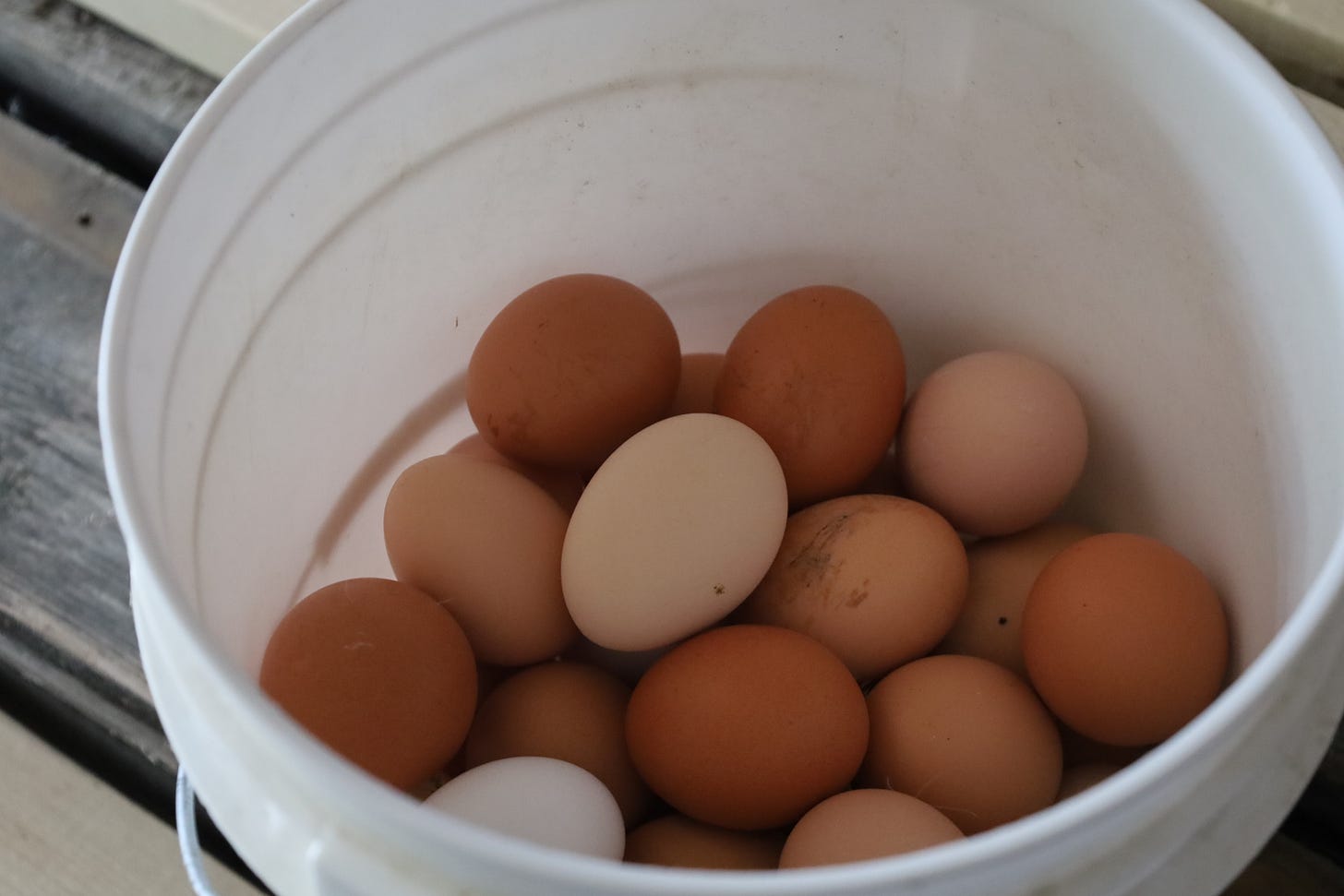The shirt hit the floor more quickly than most shirts do at the Genuine Faux Farm and it seemed to compress itself into a relatively compact mound. It was almost as if gravity had a greater pull than it usually does. And when the shirt made contact with the floor, there was an audible "splat!”
This was not a unique experience for me. Working outside in the heat causes me to sweat and soak through shirts - and I’m glad that it does. The alternative would be to overheat, which would be far more unpleasant than the miniature battle I must engage in to pull off soaking wet clothing.
Wet Clothing Hazards
This past week has featured a number of three t-shirt days, which is a unit we have used for years at the farm to measure our physical effort combined with the heat index. I can’t remember anymore, but I think my record is actually six t-shirts in one day. Some of our recent episodes have included full uniform changes - including jeans that were devoid of dry spots.
Do shins sweat? It sure looked like they do.
I recognize that it may sound a bit silly for me to keep changing if I’m just going to sweat through the next set of clothing. But there are practical considerations. If you have never worked in wet clothes, you might not realize that there are different levels of dampness. If you keep trying to move around in clothing that has reached a certain level of its water holding capacity there will be chafing.
And chafing is a good way to ensure that future work is not going to get done.
The other issue is that now, more than ever, I alternate my farm work with other tasks. While my meetings for the PAN job are on Zoom, I don’t need to be sitting in soaked clothing and inhaling my own stench for the hour that a typical meeting lasts. It’s also not considered good form to make squishy noises as you move to hand farm-fresh eggs or vegetables to a customer.
I’ve been told there is a certain “ick” factor involved.
And there is one more thing that is actually a real issue. Wet clothing is heavier and harder to move in.
If you’re working hard enough that you are sweating that much, you probably don’t need that much extra weight adding resistance. Unevaporated sweat begets more sweat until, eventually, the clothing just drags you right down to make your own mud puddle in the field you are cultivating.
No one wants to deal with a farmer puddle in the middle of the squash.
Valhalla Successfully Moved
Earlier this year, we reported that both of our high tunnels, Eden and Valhalla, lost their plastic. Since that time we have been able to cover Valhalla with the help of several kind people and we have made several repairs. Eden is getting closer to ready as we continue to rehabilitate the fifteen-year old structure.
These efforts have essentially put us off of our schedule for moving the buildings (among other things). Typically, we will move them in the Spring or Fall - not in the middle of the summer when the temperatures are at their warmest. This distinction is actually quite important because, when the sun is out, the solar gain from the plastic and reduction in air flow can make the inside of a high tunnel a good bit less hospitable than conditions outside.
Yes, we have the sides open. So, it’s not as bad as it could be. And we do keep an eye on each other to be sure we stay safe.
The other issue is that moving a high tunnel is not at all a passive activity. There is some real work involved. While I have most certainly gone through multiple t-shirts while hand weeding rows (a much more passive activity), it takes a bit more time to get to that point than it did with this project.
In the past, moving one of our high tunnels has taken about one full day of labor. That labor is split into some preparatory work in the day or days prior to the move, the big “moving day,” and then follow-up tasks that inevitably arise. The actual move, where we take off doors, raise end wall flaps, disconnect anchors, move the building and reconnect anchors, lower the flaps and put on doors can take three to four hours.
That wasn’t the case this time because, like so many other things at the Genuine Faux Farm, we haven’t done this on a yearly basis like we had prior to 2020. Valhalla last got moved in 2023, so there was some extra work that simply happens when time slips by.
But we managed it! The actual move went fairly smoothly even if the prep (and repairs we discovered needed doing) took more effort than usual.
There were crops inside of Valhalla in the West position that are now outdoors. They were supposed to be outside much sooner, so we are hoping the shock of losing a roof doesn’t cause too many issues. There may be some discontent now that we have taken them from their sheltered lives.
But this brings up another issue that we had to deal with immediately after the move. We had to protect these crops from critters that would be likely to desire a taste of their goodness. The deer would be all too happy to consume the beets and carrots, for example. So, the electric fence had to go up before the sun went down on the day of the move.
Double-nickel Tuesdays
Tammy and I keep track of our laying flock’s egg production by recording the number of harvested eggs on a calendar in our kitchen. As a numbers person, I will admit that collecting the numbers means more to me than they probably do for Tammy. I probably would happily collect the numbers simply because they are numbers. But even Tammy will admit that there are practical reasons for routinely counting and recording production.
For a long time the current flock was producing five to six dozen eggs every day. Presently, we are collecting from 50 to 55 eggs a day. Based on our history, this a fairly normal trend for our flocks as we experience warmer weather and our chickens age. We know this is normal because we have the records and the experience to tell us that this is what we should expect.
The real value of record keeping comes when you need to make decisions AND when you start seeing the unexpected.
A rapid or unexpected decline in eggs could mean any number of things. But the immediate takeaway is that we need to do some investigation. Sudden production changes could simply mean that hens are laying eggs in a place we aren’t checking. Or it is possible that we have a problem with eggs being consumed by critters (including the hens themselves). Maybe we have a batch of broody birds (though we usually have other evidence of that) or perhaps there is a problem with their environment that we could address.
It could even mean we’ve lost some chickens and we didn’t realize it.
Hey! If you’ve ever TRIED to count chickens when they aren’t on perches sleeping, you know it’s darned near impossible to get an accurate count. And if you’ve ever tried to count roosting chickens when you’re very tired at the end of a long three t-shirt day, you can’t begin to understand how hard counting can become at that point.
So, lower egg numbers could mean that we were having laying hen fatalities as a mother raccoon teaches her young to kill and eat our birds. It’s happened, and it was the egg production numbers that tipped us off to the problem.
Happily, this flock has done well and there are no unexplained issues with production so far this year. And, as I mentioned, the maximum number of eggs has been fifty-five in recent weeks. Double nickels.
Which brings me to tired farmers doing tired farmer things.
Tammy came in at the end of the day on Tuesday (July 1) after closing up the birds and collecting the last of the eggs. She did not turn on the light in the kitchen and tried to write the amount down (55 eggs) on our calendar. The next day, I noticed she had written that number down for July 8, one week into the future.
So, I crossed it off and put “55” in its correct spot for July 1.
This Tuesday, once the eggs were collected, I went to the calendar to write down that day’s harvest. It turns out that Tammy had correctly prognosticated the future. We had 55 eggs. There was no need for me to cross that number off of the calendar.
I wonder if we just write down the number of eggs we WANT for each day will we get them? I doubt that, but I do wonder how long we can have “double-nickel Tuesdays?”








I enjoy these "What's happening at Faux Farm" reports that give us readers a good sense of what happens day-to-day; it keeps us mindful of the work and the joy of raising food. Thanks, Rob.